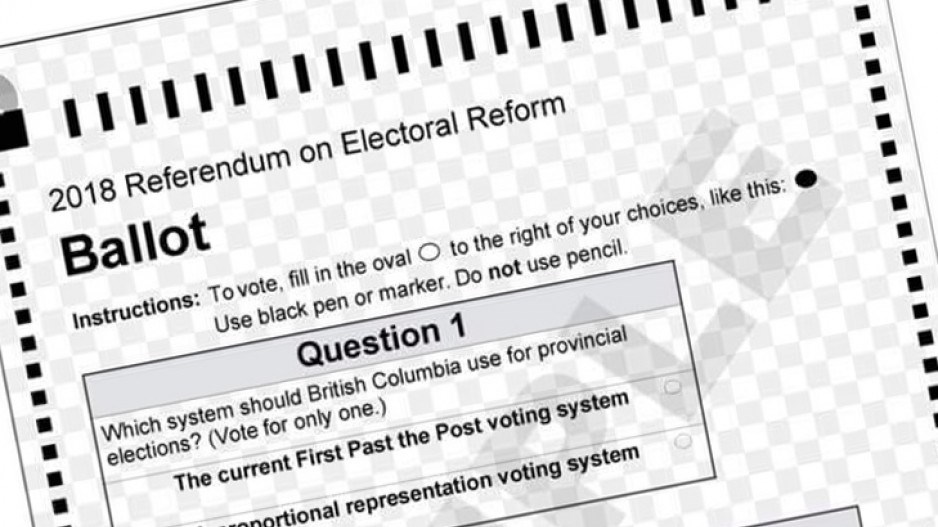British Columbians won’t be using a new voting system for the next provincial election after voters rejected a switch to proportional representation (PR) by 61.3%.
Of 3,297,395 registered voters, 1,430,358 voted. Of those, 38.7% approved electoral change, said Chief Electoral Officer Anton Boegman.
As a result, B.C. will continue to use the current first past the post (FPTP) voting system.
Of votes to change to a PR system, 41.24% supported mixed member proportional (MMP), 29.45% supported dual member proportional and 29.51% chose rural-urban proportional (RUP).
A decision either way in the binding referendum required 50% plus one to pass.
Both BC NDP Premier John Horgan and BC Green Party Leader Andrew Weaver expressed disappointment at the vote.
“British Columbians have now spoken and chosen to stick with the current voting system,” Horgan said. “This referendum was held because we believe that this decision needed to be up to people, not politicians. While many people, myself included, are disappointed in the outcome, we respect people’s decision.”
Said Weaver, “We campaigned on proportional representation because representative democracy is one of the six core principles of the BC Green Party.
“We will continue to champion policies that will strengthen B.C.’s democracy and make it more responsive to and representative of the people of B.C.”
Deputy Premier and Finance Minister Carole James called the referendum campaign vigorous and passionate.
“We will use first pas the post for the next election.” James said. “I think electoral reform is dead. Now, we move on.”
James said she didn’t believe the decision might result in the Green Party, which potentially could have benefitted from PR, withdrawing from the Confidence and Supply Agreement between the NDP and the Greens that keeps Horgan in the premier’s office.
Those opposing a change to PR said voters had sent a clear message to Victoria.
B.C. Liberal Party Opposition Leader Andrew Wilkinson said retaining FPTP was about keeping power in the hands of the electorate.
“This was a flawed process from the beginning as the NDP stacked the deck to satisfy the Green Party and remain in power,” Wilkinson said This has never been about improving our democracy, it was always about power and control.”
He said British Columbians elected to stick with a voting system seen as fair and not an open door to radicals.
“They wanted to stick with the system that they know has worked for nearly 150 years,” he said.
Wilkinson said the $15 million spent on the referendum was a waste of money. “It failed dismally.”
The Greater Vancouver Board of Trade welcomed the result, saying FPTP provides greater stability and government accountability than a proportional representation voting system.
Under a first-past-the-post electoral system, voters are empowered to hold individual MLAs and political parties accountable for their decisions,” board president Iain Black said. “This direct line of transparent accountability is crucial when it comes time for British Columbians to cast their ballots.”
Maria Dobrinskaya of the Vote PR BC campaign — one of two government-sanctioned and publicly-funded advertisers – called the vote disappointing yet fair and clear.
She said several factors led to the No vote, including a lack of appetite to revisit the issue once more and the referendum questions being complicated. And, she added, the partisanship displayed during the voting period “exemplified some of the most problematic aspects of our system.”
Dobrinskaya took issue with so-called “fear mongering” from the ‘No’ side, which alluded to far-right, Nazi takeovers under PR systems.
“Obviously I disagreed with a number of tactics. Fear is clearly effective. But it doesn’t encourage the politics I’m trying to build. It increases alienation and cynicism.”
Bill Tieleman and former Liberal attorney general Suzanne Anton headed the No side.
Tieleman said the campaign said at the campaign start the referendum was confusing, something he said is reflected in the result. And, he said, it’s the second time in nine years proportional representation has been rejected by 61%.
“Proportional representation is finished,” he said. “It’s not an option for British Columbia in the future.”
He cautioned New Democrats to take note that a majority of NDP ridings voted against PR, suggesting NDP voters did not agree with the party position supporting the proposed change.
A total of 1,391,423 ballots were returned. There were 1,378,753 valid votes for Question 1 on whether or not to change from FPTP and 831,760 valid votes for Question 2 where voters had to choose between the three PR choices. Some 2,461 ballots were rejected.
None of the proportional representation voting systems won more than 50% in the first round of counting of all three choices.
With the fewest votes, RUP was eliminated and its votes transferred to voters’ second preferences.
In the second round of counting, MMP received a majority of votes with 63.05% (491,630) of the continuing ballots.
Of British Columbia’s 87 provincial ridings, only 15 chose proportional representation. Six of those ridings are in Vancouver.
A significant number of ridings in Surrey, Richmond, the Okanagan and the Fraser Valley rejected PR. The highest rejection numbers came from the Peace River North and Peace River South riding votes of 86.42% and 84.47% respectively.
The campaign was contentious if not bitter at times, as both sides accused each other of misleading voters. Yes vote proponents accused the No side of fearmongering while the No side accused counterparts of confusing the electorate.
In the 2005 and 2009 electoral reform referendums, the choice was a simple Yes or No to moving to single transferable vote.
Ballots were being verified and checked to ensure were no duplicates or spoiled ballots as they arrived at secure Elections BC locations in Victoria by the December 7 deadline.
The final tally came after a so-called risk audit in which test ballots were run through ballot-tallying machines to ensure they worked properly.
MMP is used in Germany, New Zealand and Scotland.




